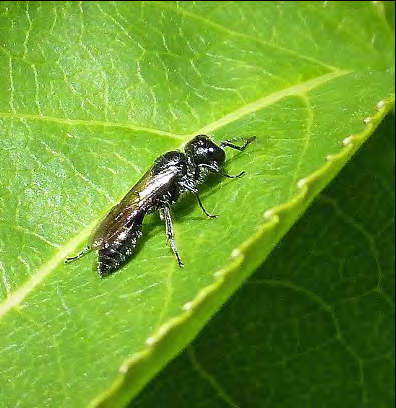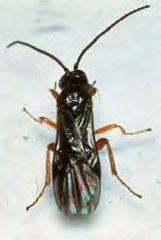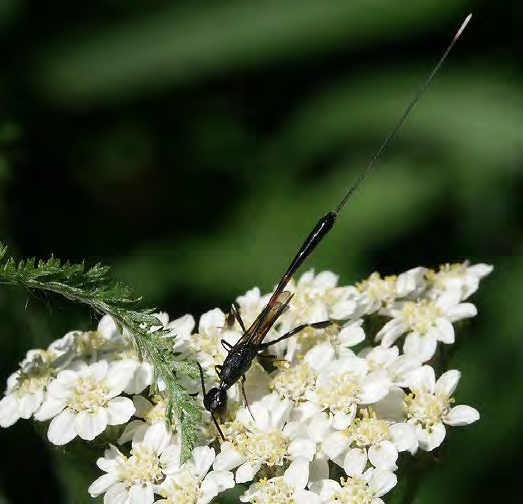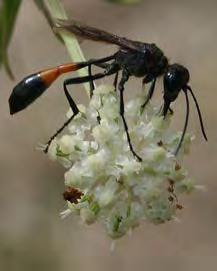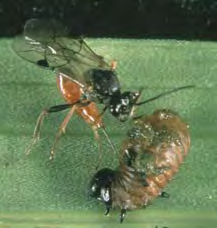Beneficial Arthropods of Alaska: Natural Enemies
PMC-10075 View this publication in PDF form to print or download.
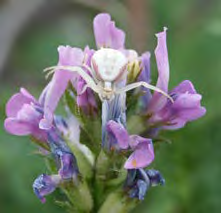
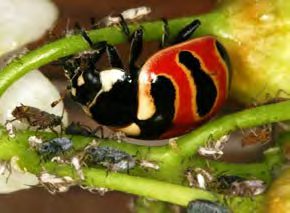
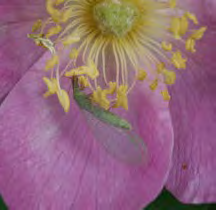
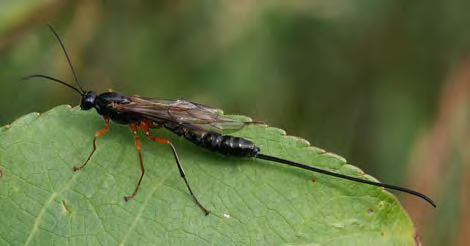
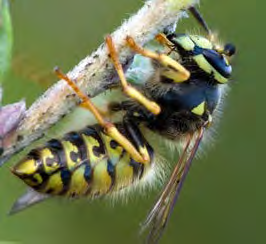
Cover photos, left to right:
Top row: crab spider (Misumena vatia), Dave Guinn; three-banded lady beetle (Coccinella trifasciata perplexa) eating aphids, Aaron Hagerty; green lacewing (Chrysopidae), Dave Guinn Bottom row: parasitoid wasp (Ichneumonidae), Dave Guinn; aerial yellowjacket (Dolichovespula arenaria), Derek Sikes
Table of Contents
- Introduction
- Beneficial Spiders and Their Relatives
- Daddy Long Legs or Harvestman (Order: Opiliones)
- Wolf Spiders (Family: Lycosidae)
- Crab Spiders (Family: Thomisidae)
- Orb-weaver Spiders (Family: Araneidae)
- Beneficial Insects: Introduction
- Damsel Bugs, Nabids (Family: Nabidae)
- Lacewings (Order: Neuroptera)
- Ground Beetles (Family: Carabidae)
- Rove Beetles (Family:
- Lady Beetles (Family: Coccinellidae)
- Flower Flies (Family:
- Robber Flies (Family: Asilidae)
- Yellowjackets (Family: Vespidae)
- Square-headed and Aphid Wasps (Family: Crabronidae)
- Parasitoid Wasps (Order: Hymenoptera)
- Parasitoid Flies (Family:
- Stone Centipedes (Order: Lithobiomorpha)
- Photo Credits
- Photo Identifications for Known Taxa
- References
- Acknowledgements
Introduction
Gardens and agricultural systems support a community of small invertebrates, including pests and their natural enemies. Natural enemies are organisms that consume pests and can help keep pest populations below damaging levels. We consider these natural enemies to be beneficial organisms in our environments and an important component of integrated pest management strategies. Natural enemies are particularly important in low-input and organic systems, where they may be a primary component of a pest management program. Natural enemies can be divided into three broad categories: predators, parasitoids, and pathogens. This booklet will cover common predators and parasitoids.
Predators hunt and consume other species to survive. Insects may be predators in either the immature or adult stage or both. Adult parasitoids deposit eggs in, on or near the body of their host. When the eggs hatch, the larvae feed on the host’s body while it is still alive and eventually cause mortality. Adult parasitoids are generally free-living, feeding on nectar or pollen. Pathogens are microorganisms (fungi, bacteria or viruses) that produce disease and lead to death.
Additional information on identification of beneficial organisms and encouraging and incorporating them into your pest management program is available through your local Cooperative Extension Service office.
Beneficial Spiders and Their Relatives
Identification
Spiders are characterized by having four pairs of legs and two body regions, the cephalothorax (head and thorax combined) and abdomen, usually separated by a waist constriction.
Spiders are distinguished by spinnerets, the silk and web-spinning organs at the rear of the abdomen. Spinnerets may or may not be immediately visible on all spiders.
Habits
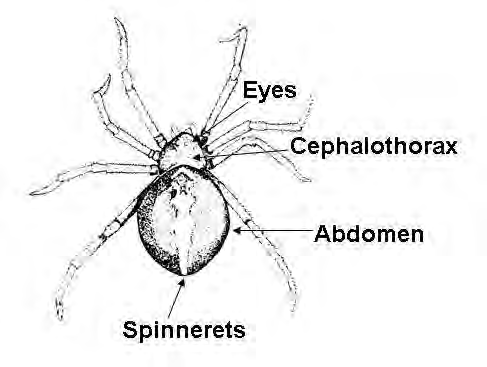 All spiders in Alaska are predators, feeding on insects and other small arthropods.
Most spiders are docile and harmless to humans.
All spiders in Alaska are predators, feeding on insects and other small arthropods.
Most spiders are docile and harmless to humans.
Some spiders construct webs to ensnare prey; others do not spin webs but actively pursue prey in a hunting manner. The spiders outlined in this booklet have been included because of their likelihood to be present in a garden or crop setting in Alaska. Exclusion of any family of spiders does not indicate their absence from the state or a lack of beneficial qualities. Attract spiders by providing a variety of plant structures that offer harborage and habitat for them.
Beneficial Spiders and Their Relatives
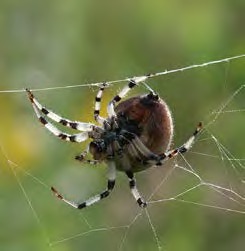
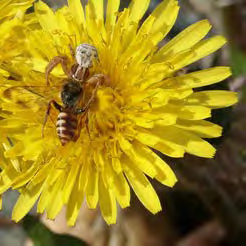
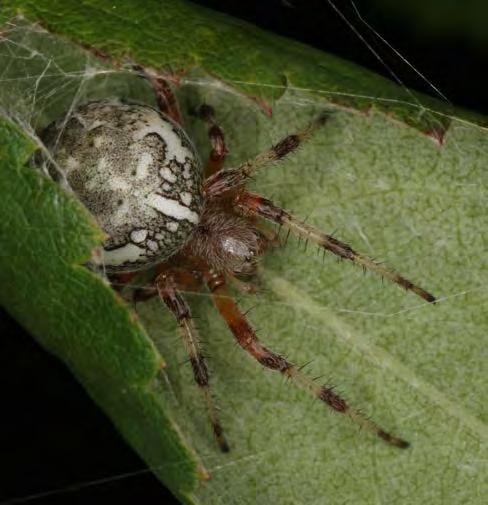
Daddy Long Legs or Harvestman (Order: Opiliones)
Identification
Harvestmen species are not true spiders but are close relatives of spiders. They lack a constricted waist and spinnerets. Harvestmen have a small, pea-sized body and eight slender legs. Legs can be either long or short.
The upper surface of the body is usually a mottled grey and brown coloration, while the underside is a cream color.
Web Type
Harvestmen do not spin a web.
Habits
Harvestmen are generalist predators, feeding on soft-bodied insects, some beetle larvae, slugs and snails, and decaying organic matter. Harvestmen use special glands that produce strong-smelling secretions for defense. They deposit their eggs in soil, in cracks or crevices and under bark.
There are several harvestman species in Alaska; they are most frequently found in undisturbed forest sites and agricultural fields.
Daddy Long Legs or Harvestman (Order: Opiliones)
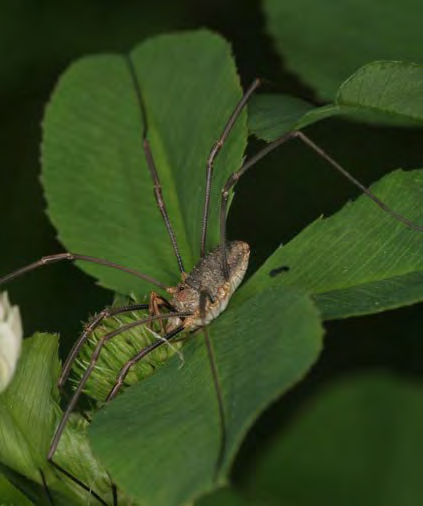
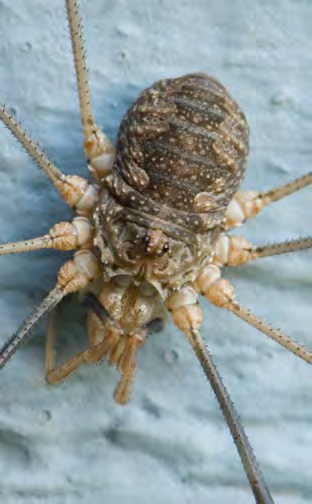
Wolf Spiders (Family: Lycosidae)
Identification
Wolf spiders have highly variable gray and brown color patterns to match their surroundings. They are moderately sized spiders, most being about one half an inch in length.
Web Type
Wolf spiders don’t spin a capture web, but they will spin silk-lined retreats and burrows. Females also will spin a silk egg sac.
Habits
Wolf spiders are fast and are often seen running from disturbances or danger. They have excellent eyesight and are active predators.
Some species make tunnels in the ground or use natural depressions such as rocks or cracks for retreats, while others are found in grass, leaf litter or stony areas. While usually found hunting on the ground, they will also climb trees and the sides of buildings looking for prey.
Female wolf spiders carry egg sacs under their spinnerets. After hatching, the tiny spiderlings climb onto the abdomen of the mother, where they remain anywhere from a day to two weeks.
In Alaska, wolf spiders are encountered around the yard and garden and sometimes even in homes. Attract wolf spiders by maintaining a few permanent plantings. Edging, wooden walkways and mulch also provide shelter.
Wolf Spiders (Family: Lycosidae)
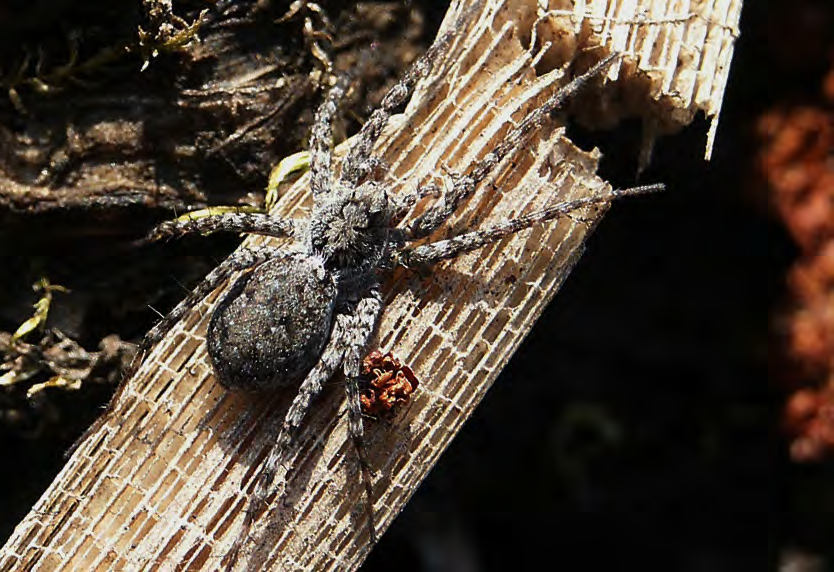
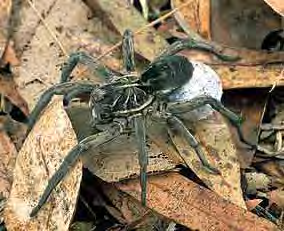
Crab Spiders (Family: Thomisidae)
Identification
Crab spiders’ first and second pairs of legs are much longer than the last two pairs, giving them a crab-like appearance. Additionally, they lay flat and scuttle much like a crab.
They are usually mottled to match their environment, and use this camouflage to aid in catching prey.
Web Type
Crab spiders do not spin capture webs, but will spin egg sacs and retreats.
Habits
Crab spiders secure their prey by ambush and stealth and can often be found on flowers in the garden setting.
Camouflaged, they lie in wait for prey — sometimes for days. They also stalk their prey on the ground. This family of spiders relies more on touch than eyesight to detect prey.
Some species may slowly change color to match their flower perch. They also will build retreats by curling flower petals and terminal leaves.
Attract crab spiders by providing a variety of flowers for hunting, and ground covers to provide areas for them to retire to.
Crab Spiders (Family: Thomisidae)
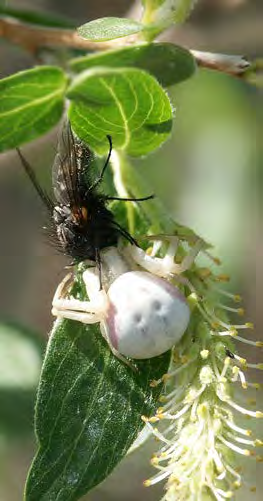
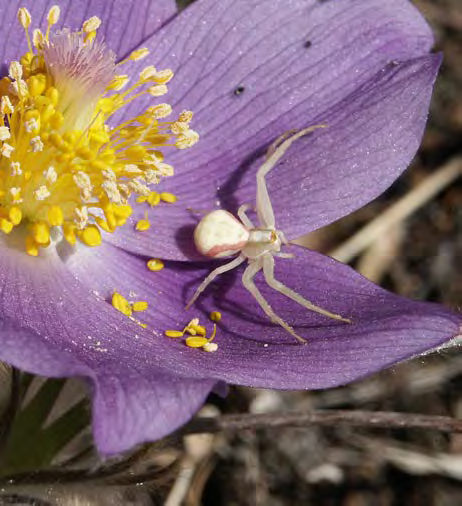
Orb-weaver Spiders (Family: Araneidae)
Identification
Orb-weavers are highly varied in size and coloration. The Alaska examples shown here are large species with brightly patterned abdomens and leg markings. Other species are smaller and more drab. Males are often much smaller than females.
Web Type
Orb-weavers are so named because they construct a web made up of concentric circles of silk anchored to the surrounding vegetation.
Most people are familiar with this “Charlotte’s Web” pattern.
Habits
Orb-weavers are most famous for their web engineering. They and their webs are commonly found on or near plants in the garden and on the exteriors of homes and decks.
With reduced eyes, Orb-weavers rely on the vibration of the web to indicate when prey has been captured.
Females camouflage egg sacs within the web or sometimes bury them in leaf duff or cracks and creases of homes.
Members of this group are some of the largest spiders likely to be encountered in Alaska gardens. You can attract them by providing a variety of structures for them to use for their webs, like lattices and frames.
Orb-weaver Spiders (Family: Araneidae)
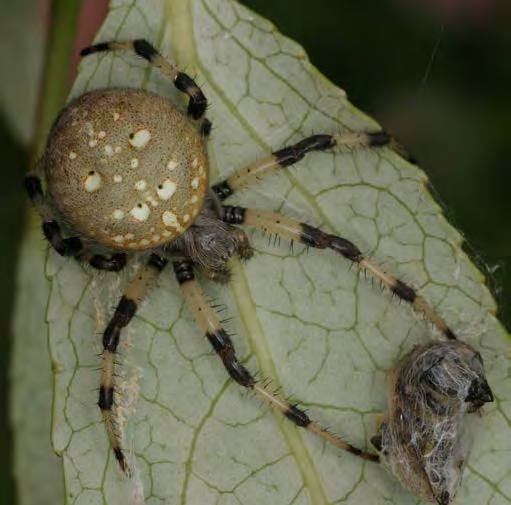
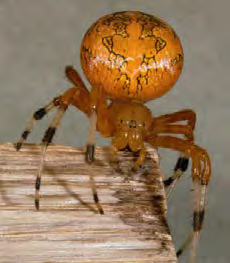
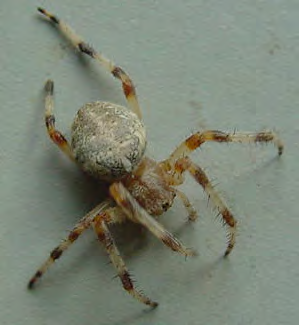
Beneficial Insects: Introduction
Insects are characterized by three pairs of legs, three body regions — head, thorax and abdomen — and two antennae. Insects are incredibly diverse. Body size and coloration vary dramatically, as do feeding habits. Insects may feed on plants, animals, fungi, detritus, etc. Most insects are harmless to humans and our crops.
Insects occupy a wide range of habitats and possess a vast array of habits. Insects have colonized the great majority of Earth’s ecosystems with one main exception — saltwater environments.
A great many insects are beneficial or benign, pollinating both wild and cultivated plants, feeding on pest organisms, and serving as food sources for birds, fish and mammals. Others are important agricultural and human health pests.
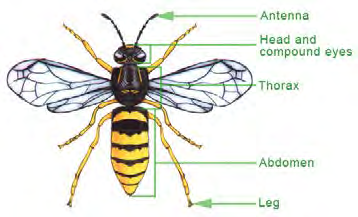 Insect growth and development also vary. The beneficial insects described in this
booklet, with the exception of damsel bugs, undergo complete metamorphosis. They develop
through four life stages including egg, larva, pupa and adult. Damsel bugs undergo
simple metamorphosis with three life stages including egg, nymph and adult. Each life
stage is described for the beneficial groups presented.
Insect growth and development also vary. The beneficial insects described in this
booklet, with the exception of damsel bugs, undergo complete metamorphosis. They develop
through four life stages including egg, larva, pupa and adult. Damsel bugs undergo
simple metamorphosis with three life stages including egg, nymph and adult. Each life
stage is described for the beneficial groups presented.
Beneficial Insects: Introduction
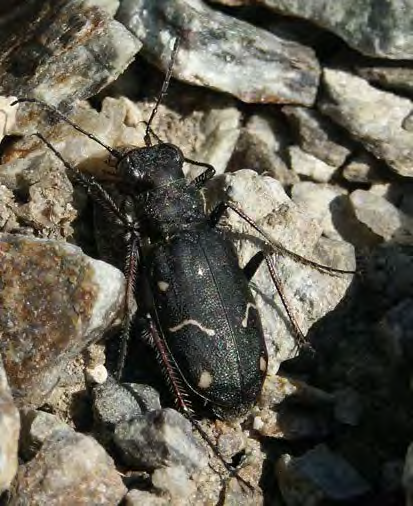
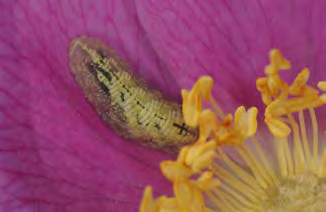
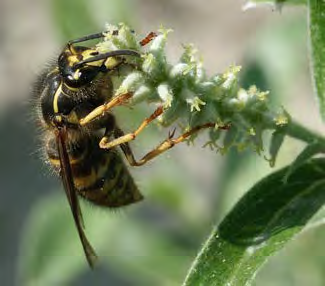
Damsel Bugs, Nabids (Family: Nabidae)
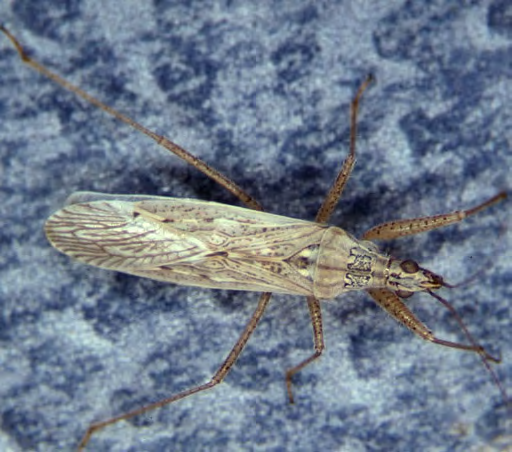 The mouthparts of damsel bugs (aka nabids) are elongated into a beak and are held
folded under the head. When prey is captured, the beak is extended and sharp stylets
puncture the prey and then suck out the body contents.
The mouthparts of damsel bugs (aka nabids) are elongated into a beak and are held
folded under the head. When prey is captured, the beak is extended and sharp stylets
puncture the prey and then suck out the body contents.
Damsel bugs are known to feed on agricultural pests such as aphids, plant bugs, mites, moth eggs and small caterpillars. Although generally beneficial, damsel bugs can produce a painful bite if handled.
Identification
Adults: Narrow oval body measuring approximately 1 centimeter, usually yellowish brown in color. Legs and antennae are long and head appears pointed.
Immatures: Similar in appearance to the adults but lack wings, measuring 1-7 millimeters.
Eggs: Small, cream-colored to white, laid on foliage or inserted in plant tissue.
Habits
Damsel bugs are found in the garden, in tall grass and other vegetative cover. Maintain natural grassy areas around the garden to encourage this predator.
Damsel Bugs, Nabids (Family: Nabidae)
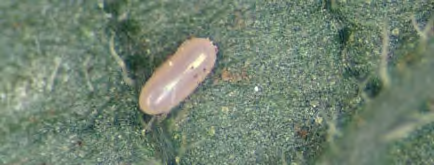
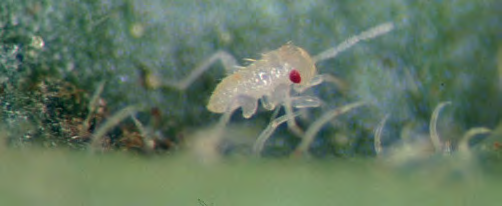
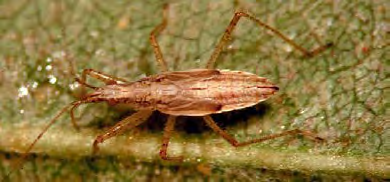
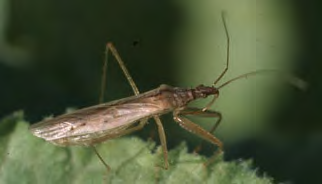
Lacewings (Order: Neuroptera)
Lacewings are part of a large order of mostly predaceous insects. In Alaska, we most commonly see green lacewings and brown lacewings, which are important predators of aphids, mites, whiteflies and the eggs of some economically destructive caterpillars.
Some species of lacewings can be difficult to tell apart. Fortunately, they are all beneficial and easy to identify as a group. Lacewings are distinct because their wings contain many veins, which give them a lacy appearance.
Identification
Adults: Soft-bodied with four membranous wings held roof-like over the back; eyes are gold or copper metallic. Green lacewings are larger with an overall greenish tint, measuring 15-25 centimeters. Brown lacewings are smaller and brown in color, measuring 6-12 millimeters.
Pupae: Green lacewing: Small, round cocoon attached to foliage. Brown lacewing: Small, elongate cocoon attached to foliage or under bark.
Larvae: Both green and brown lacewings are “alligator-like” in appearance with long sickle-shaped mandibles. The body can vary from gray-green to red-brown in color with bumps or knobs.
Eggs: Small and cream-colored. Green lacewing eggs are laid at the end of long, delicate stalks attached to vegetation near prey. Brown lacewing eggs are oval and laid directly on leaves.
Lacewings (Order: Neuroptera)
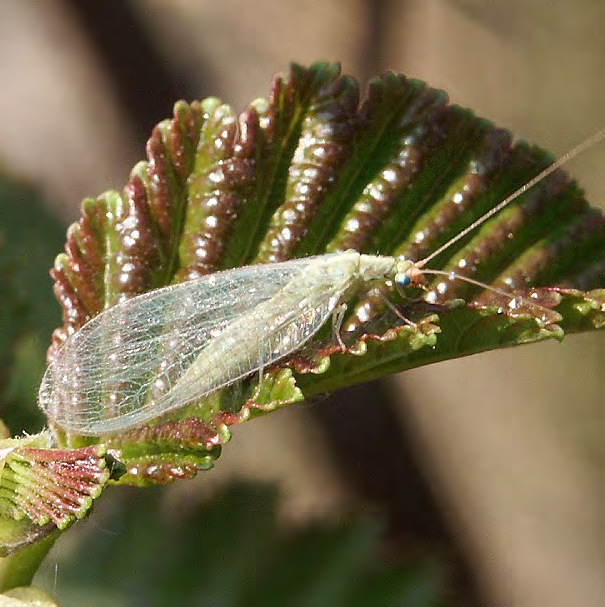
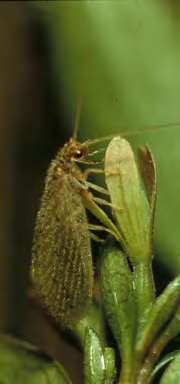
Lacewings (Order: Neuroptera)
Habits
Adult green and brown lacewings are night flyers; immatures are found on plant foliage. Most adults are predators, although some may feed on honeydew, pollen or nectar. Immatures are predators and primarily feed on aphids and other soft-bodied insects.
Green lacewings are commonly found around bushes, grasses and weeds while brown lacewings are common in more wooded areas.
Lacewings (Order: Neuroptera)
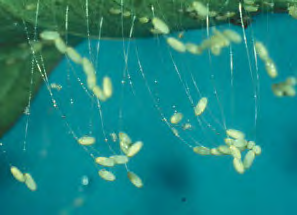
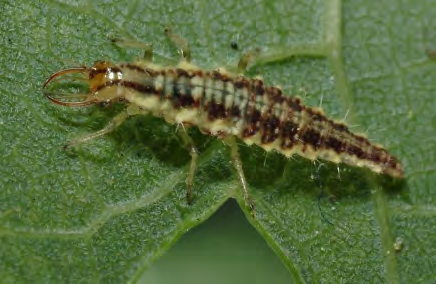

Ground Beetles (Family: Carabidae)
Ground beetles are a large group of insects that can be found in a variety of habitats. Some sources note over 200 species in the state of Alaska.
Identification
Adults: Range in size from very small to about 3 centimeters. Body form is usually oval with long walking legs. Coloration is usually black or brown, but some beetles have striking blue or green iridescence.
Larvae: Body resembles a flattened caterpillar with long legs; head with distinct mandibles.
Eggs and pupae: Found in soil and under debris.
Habits
As generalist predators, adults and larvae actively hunt a wide variety of prey, including caterpillars, immature flies, slugs, terrestrial snails, earthworms, springtails, and even weed seeds. Almost any invertebrate that spends a portion of its life cycle close to the ground is fair game for ground beetles.
Permanent plantings, wooden terraces, walkways and mulch can provide shelter and increase populations of ground beetles around the yard and garden.
Ground Beetles (Family: Carabidae)
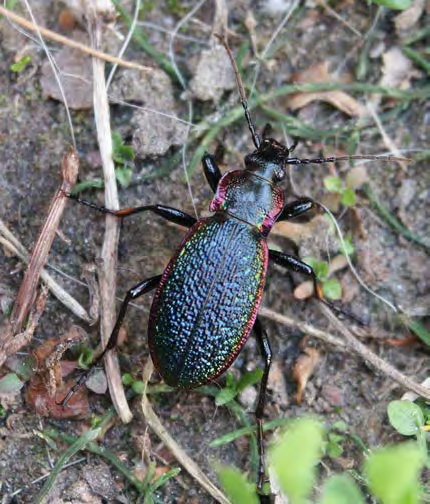
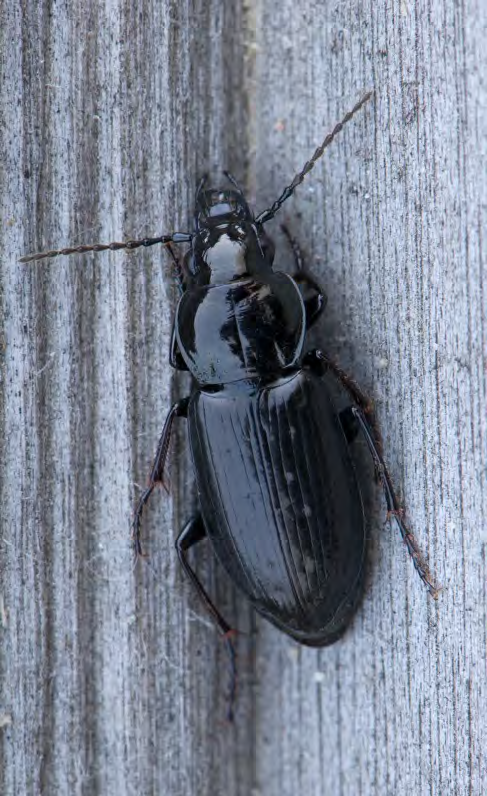
Rove Beetles (Family: Staphylinidae)
There are several hundred species of rove beetles in Alaska. This large family of beetles is exceptionally diverse both in appearance and in ecology.
Identification
Rove beetles are typically brown or black in color and range in length from only a few millimeters to over a centimeter. In general, rove beetles are distinguished from other groups of beetles by their short elytra (wing covers), which do not fully cover their abdomens.
Habits
Most rove beetles adults and larvae are predaceous on other insects and small invertebrates. They can be found in leaf litter, under rocks or logs, or near sources of freshwater. Some species are found in carrion or decaying fungi. The rove beetle genus Aleochara includes species that serve as important natural enemies of both onion and cabbage root maggots.
Some rove beetles release defensive compounds from glands located near the tip of the abdomen when threatened.
Rove Beetles (Family: Staphylinidae)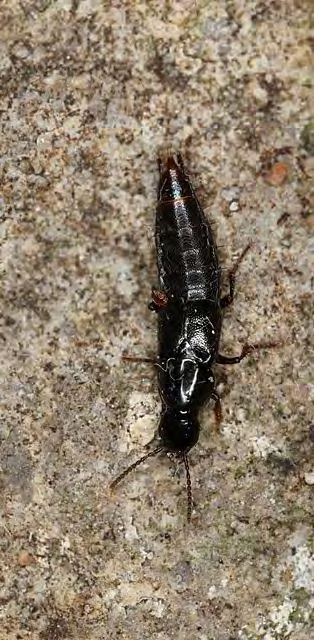
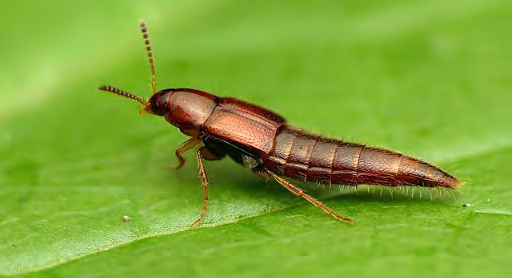
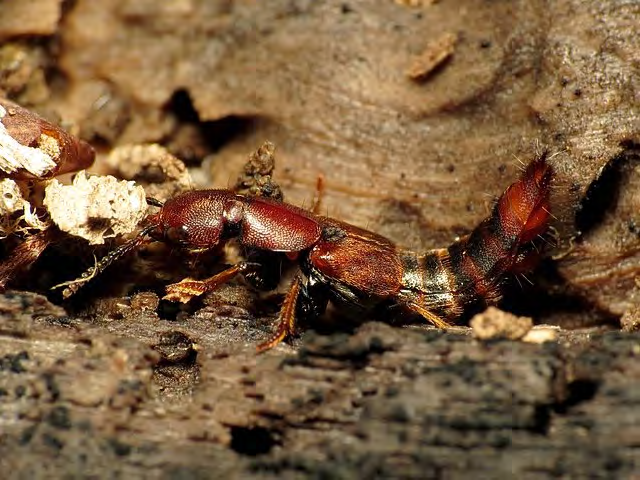
Lady Beetles (Family: Coccinellidae)
Lady beetles are a well known and diverse group of primarily predaceous beetles. The beneficial status of lady beetles has been known for hundreds of years, and they are considered a harbinger of good tidings in many cultures.
Adults and immatures are voracious, active predators of aphids, scale insects and other soft-bodied pests.
Since the early 1900s, their populations have been encouraged, and species have been introduced into new areas for control of agricultural and garden pests.
In recent years, it has been shown that introduction of non-native species can be detrimental to the ecosystem; some introduced lady beetles tend to outcompete native species and reduce their numbers. More than 20 species of predaceous lady beetles have been recorded from Alaska.
Lady Beetles (Family: Coccinellidae)
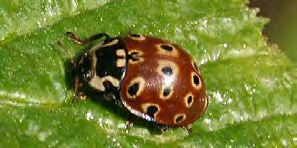
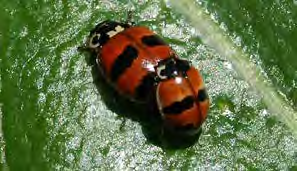
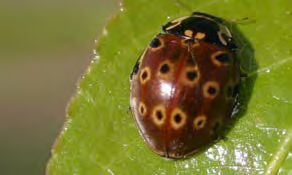
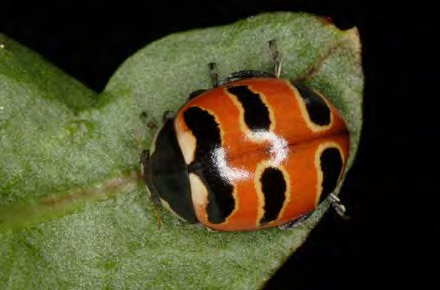
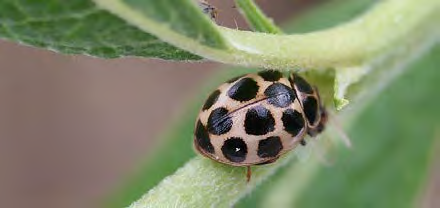
Lady Beetles (Family: Coccinellidae)
Identification
Adults: The 1-10 millimeter body is convex, round to oval, often brightly colored red, orange or cream with dark spots or stripes. They can be distinguished from other colorful beetles by their short, clubbed antennae and hidden head.
Pupae: Pupae are 2-8 millimeters and similar to larvae in coloration and are found attached to plants.
Larvae: Dark gray to black, often with bright bands or spots. Body flattened and “alligator-like” in appearance with spines or bumps on the back.
Eggs: Oval to spindle shaped, yellow-orange in color, often laid in clusters on plants.
Habits
Lady beetles are commonly encountered in agricultural, garden and residential areas. Adults and immatures can be found on grasses, bushes, trees and garden plants.
Lady beetles pass the winter as adults under leaf litter and other debris.
Lady Beetles (Family: Coccinellidae)
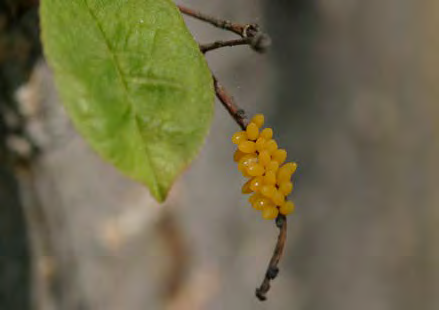
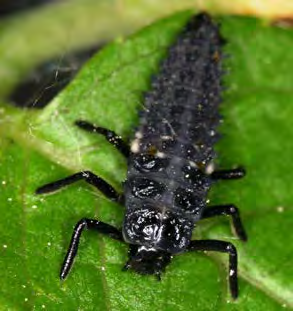
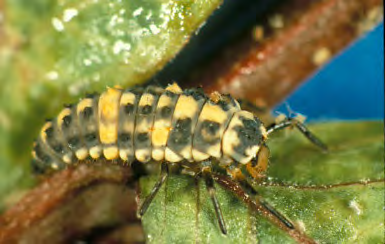
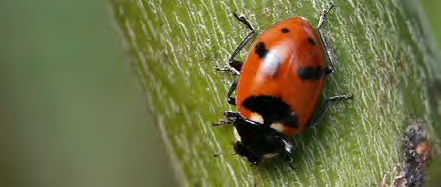
Flower Flies (Family: Syrphidae)
Flower flies are familiar, colorful insects that are often seen hovering around flowers like helicopters. Although adults closely resemble bees or wasps, they are harmless and do not sting or bite. The immatures of some species are beneficial, feeding on aphids and other soft-bodied insects.
Identification
Adults: Medium-to-large flies; bodies usually brightly colored with yellow and black bands that mimic wasps and bees. Pupae: Small and tan, attached to foliage.
Larvae: Most are slug-like maggots, gray-green or creamy white with variable darker markings. Head end usually narrowed. Others may resemble spiny maggots.
Eggs: Small, oval and cream colored, often laid on foliage near aphid colonies.
Habits
Adults are not predaceous but are important as pollinators, feeding primarily on pollen and nectar.
Eggs are laid singly or in groups, often among aphids. Immatures can be found on plants.
Attract adults with flowering plants around the garden.
Several species occur in Alaska, but the group is poorly studied.
Flower Flies (Family: Syrphidae)
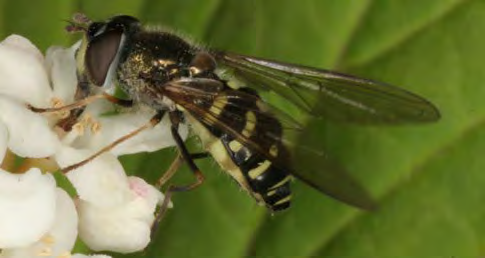
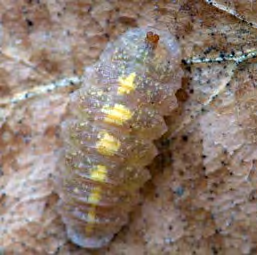
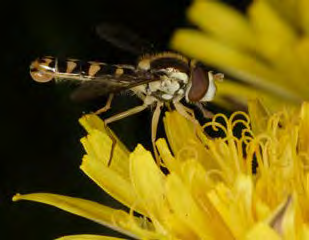
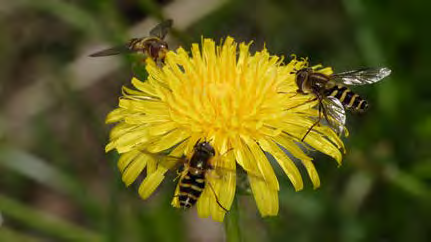
Robber Flies (Family: Asilidae)
Robber flies are a predaceous group that feed on a wide variety of insects, including wasps, bees, grasshoppers and other flies. Several species are known to occur in Alaska, but the group is poorly studied.
Identification
Adults: Medium-to-large flies. Eyes are large with a characteristic notch or depression between them. Some have bristles on their head that make them appear bearded. Most species are elongate with narrow abdomens; others are more robust and hairy and mimic bumblebees. Pupae: Not concealed within a covering.
Larvae: Body is elongated and cylindrical and can be creamy white to yellow in color. Can be difficult to distinguish from other soil-dwelling larvae.
Eggs: Variable between species.
Habits
Robber flies are found in a wide variety of habitats. However, they are most commonly encountered in grassy, open areas or forest edges. Adults pursue and capture prey in the air or capture prey resting on foliage. Adults use piercing mouthparts to inject digestive saliva into prey and then suck out the body contents.
The immatures are poorly studied; they are thought to live in rotting wood, under bark or fallen leaves or in loose soil, where they are primarily predaceous.
Robber Flies (Family: Asilidae)
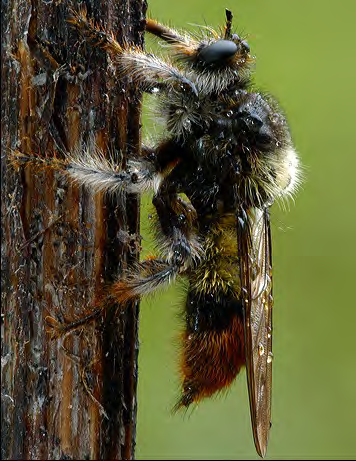
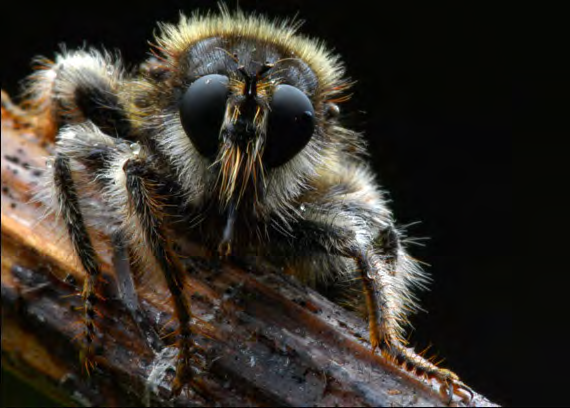
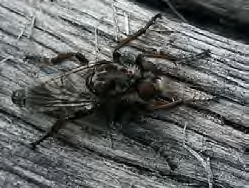
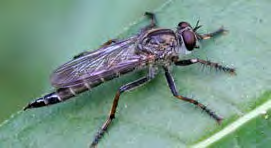
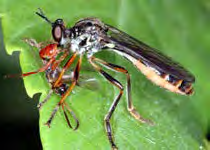
Yellowjackets (Subfamily: Vespinae)
Yellowjackets are social wasps living in colonial nests above or below ground. Some species are nuisance pests when their stinging and scavenging behavior puts them in contact with humans. The group as a whole is considered beneficial as pollinators and predators of other insects.
Identification
Adults: Medium-to-large wasps. Bodies black with yellow or ivory markings. Distinguished from bees by their relatively shiny bodies, slender body shape and wings that are held longitudinally over abdomen.
Immature life stages: Not likely to be encountered unless removing a nest.
Habits
Yellowjacket colonies consist of a single queen and daughter workers. They are efficient pollinators and voracious predators. Workers feed on nectar but will eat flies, aphids, caterpillars and other pests. The larvae are fed chewed insects by workers.
Overwintering queens emerge in the spring, construct a small nest, lay eggs and care for the developing first brood of workers. Once the workers emerge, they expand the nest, forage for food, care for the young larvae and defend the colony. The queen then devotes all her time to laying eggs. New queens and males are produced in the fall. Males leave the colony, mate with new queens and die. Only the new queen overwinters; the remainder of the colony dies.
Yellowjackets (Subfamily: Vespinae)
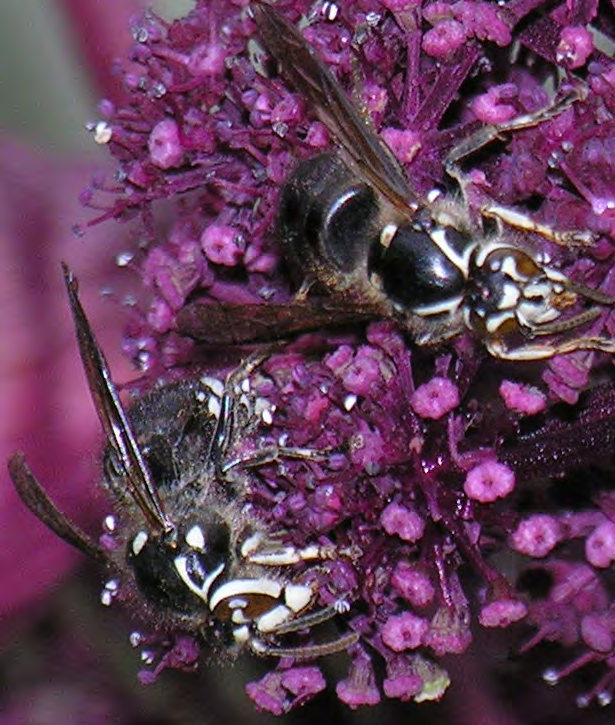
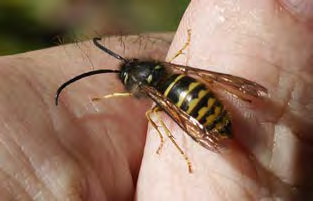
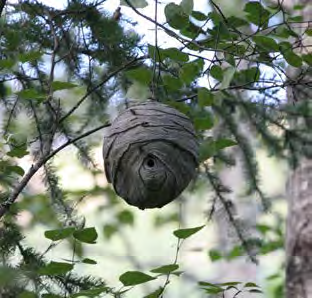
Square-headed Wasps (Subfamily: Crabroninae)
Square-headed wasps are a group of solitary wasps that are largely predaceous on flies.
Identification
Both male and female square-headed wasps get their name from their relatively square-shaped heads. These are small, dark wasps, though many members of this group are marked with bright yellow stripes. One of our most recognizable groups of square-headed wasps in Alaska are the shield-handed square-headed wasps, which get their name from the specialized morphology of the male wasps. The male’s forelegs are expanded into broad “shields,” which are thought to facilitate the female’s ability to recognize a male of her own species during mating.
Habits
Female square-headed wasps build nest cells in hollow cavities such as underground tunnels, hollow stems, or tunnels in logs left by wood-boring insects. An egg is laid in each nest cell and the cell is provisioned with paralyzed prey to feed the developing wasp. Most square-headed wasps are predaceous on flies.
Female square-headed wasps do have a stinger which they use to paralyze prey. Adult wasps may visit flowers to sip nectar. Attract adults with flowering plants around the garden.
Square-headed Wasps (Subfamily: Crabroninae)
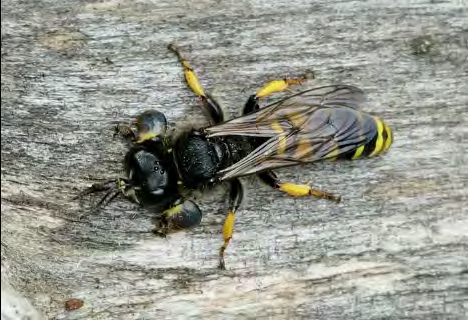
Aphid Wasps (Subfamily: Pemphredoninae)
Aphid wasps are a group of mostly solitary wasps that are largely predaceous on aphids.
Identification
Aphid wasps are small, black wasps that typically have a narrow waist and square-shaped head when viewed from above. Their faces are often adorned with shiny, silvery hairs. Most aphid wasps are about 1 centimeter in length.
Habits
Female aphid wasps build nest cells in hollow tubes, such as plant stems or tunnels left by wood-boring insects. An egg is laid in each nest cell and the cell is provisioned with paralyzed aphids to feed the developing wasp.
Female aphid wasps do have a stinger which they use to paralyze prey. Adult wasps may visit flowers to sip nectar. Attract adults with flowering plants around the garden.
Aphid Wasps (Subfamily: Pemphredoninae)
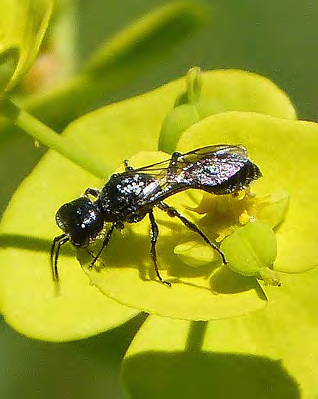
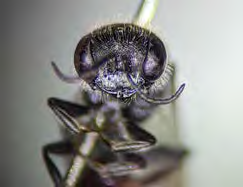
Parasitoid Wasps (Order: Hymenoptera)
Parasitoid wasps belong to several families of Hymenoptera and vary widely in appearance and habits. Immature life stages develop on or in insects or other invertebrates.
Many species of parasitoid wasps are host specific, making them useful for pest control in natural settings and greenhouses. There are many species of parasitoids that feed on aphids, fungus gnats and cutworms.
Identification
Adults: Vary in size from 1 millimeter to several centimeters. Adult wasps usually have long, thin bodies; however, some of the minute species have rather robust bodies.
Many parasitoid wasps have a very long, stinger-like ovipositor. While this structure looks impressive, it cannot be used to sting people. This appendage is used to deposit eggs into hosts. Immature life stages: Rarely seen due to their parasitic habits.
Habits
Some adults feed on pollen or nectar and are beneficial as pollinators; others are predaceous. Adults lay eggs on or in potential host insects.
The larvae develop on or inside the host, feeding on body fluids, fat deposits and organs, which eventually kills the host. Some species form characteristic cocoons on or around the dead host. Attract adults with flowering plants around the garden.
Parasitoid Wasps (Order: Hymenoptera)
Parasitoid Flies (Family: Tachinidae)
Species of parasitoid flies most commonly encountered belong to the fly family Tachinidae. Tachinid fly maggots develop inside the bodies of various species of insects. They most commonly attack caterpillars, true bugs, beetles and grasshoppers.
Identification
Adults: Small to medium-sized flies, often with many hairs or bristles. Many species appear similar to common house or filth flies.
Immature life stages: Rarely seen due to their parasitic habits.
Habits
Adult flies lay eggs directly on the host or on something the host will eat. When the eggs hatch, the parasitoid larvae enter the host through the body wall or are consumed by the host as it feeds. The larvae develop inside the host, feeding on body fluids, fat deposits and organs.
Once parasitoid development is complete, the larvae will bore out of the host body, killing it, and pupate in the soil. Most adult flies feed on honeydew, nectar or pollen.
Parasitoid Flies (Family: Tachinidae)
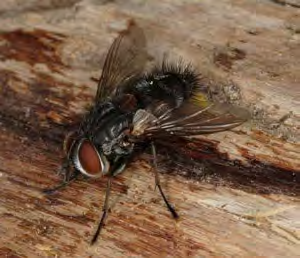
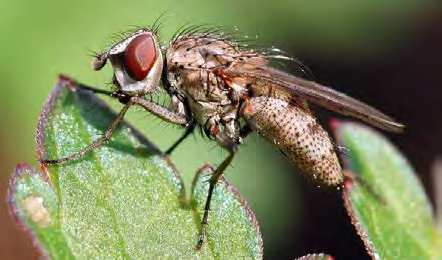
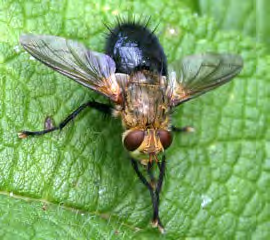
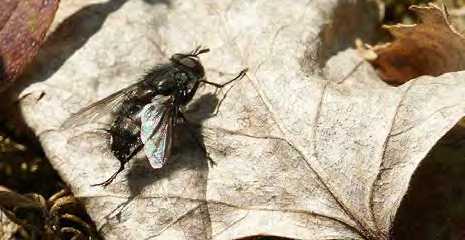
Stone Centipedes (Order: Lithobiomorpha)
Centipedes are neither spiders nor insects, instead belonging to a group called the ‘myriapods’ along with millipedes.
Identification
Centipedes are characterized by having an elongated body made up of many segments, the majority of which bear one pair of legs. Stone centipedes typically have 15 pairs of legs as adults, juveniles have fewer. Stone centipedes are tan to reddish brown in color and range from 4-40 millimeters in length.
Most centipedes produce venom, which they use to subdue their prey. Venom is injected into the prey through pincer-like appendages called ‘forcipules’ located below the head. Centipedes often flee when disturbed but may bite if handled.
Habits
All centipedes in Alaska are predaceous, feeding on insects and other small arthropods. Stone centipedes can be found in soil or leaf litter, under stones or logs, and within decaying wood.
Females lay eggs singly in the soil. Stone centipedes are relatively long-lived; it can take them over a year to reach maturity and they may live for several years.
Stone Centipedes (Order: Lithobiomorpha)
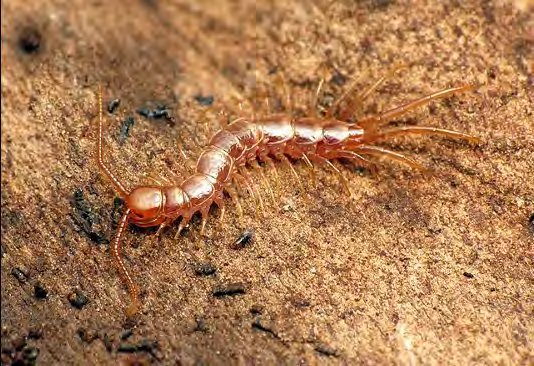
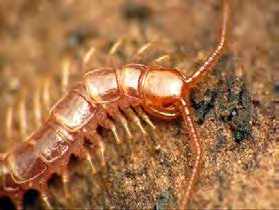
Photo Credits
Joseph Berger, www.forestryimages.com. Photo: 24
David Cappaert, www.forestryimages.com. Photos: 47, 48, 61, 62
Whitney Cranshaw, Colorado State University, www.forestryimages.org. Photos: 16, 17, 19
Dave Guinn, akbugzy@mac.com. Photos: 1, 2, 3, 4, 6, 8, 9, 10, 13, 14, 15, 22, 26, 31, 32, 34, 35, 39, 40, 42, 43, 45, 50, 51, 57, 58, 60, 63
Aaron Hagerty, USDA Agricultural Research Service. Photos: 33, 36, 37
Tim Haye, Universität Kiel, www.insectimages.org. Photo: 59
Bradley Higbee, Paramount Farming, www.forestryimages.org. Photo: 18
Gerald Lenhard, www.forestryimages.org. Photo: 11
D. McClenaghan, www.ento.csiro.au. Photo: 7
R.J. Reynolds Tobacco Company Slide Set, R.J. Reynolds Tobacco Company, www.insectimages.org. Photo: 56
Corlene Rose, UAF Cooperative Extension Service. Photo: 49
Derek S. Sikes, © 2007. Photos: 5, 25, 27, 41, 44, 60
Alton N. Sparks, Jr., University of Georgia, www.forestryimages.org. Photo: 20
Cathy Turner, UAF Cooperative Extension Service. Photo: 12
UAF Cooperative Extension Service Staff. Photos: 21, 23, 38
Katja Schulz, commons.wikimedia.org. Photos: 28, 30, 64, 65
Gail Hampshire, commons.wikimedia.org. Photos: 53, 55
S. Rae, commons.wikimedia.org. Photo: 52
D. Hobern, commons.wikimedia.org. Photo: 29
Alexandria Wenninger, UAF Cooperative Extension Service. Photo: 54
Photo Identifications for Known Taxa
- 1, 3 Araneus trifolium
- 2 Thomisidae, Xysticus
- 4, 5 Phalangium opilio
- 6 Lycosidae, Pardosa
- 8-9 Misumena vatia
- 10 Araneus trifolium
- 11 Araneus marmoreus
- 13 Cicindella sp.
- 14 Syrphidae, Flower Fly Maggot
- 15 Dolichovespula arenaria, Common Aerial Yellowjacket
- 19-20 Nabis sp.
- 25 Chrysoperla sp.
- 26 Carabus vietinghoffii
- 27 Pterostichus adstrictus
- 31, 33 Anatis mali, Eye-Spotted Lady Beetle
- 32 Adalia bipunctata, Two-Spotted Lady Beetle
- 34 Coccinella trifasciata perplexa,Three-Banded Lady Beetle
- 35 Calvia quatuordecimguttata, Fourteen-Spotted Lady Beetle
- 39 Hippodamia quinquesignata guinquesignata, Five-Spotted Lady Beetle
- 49 Dolichovespula maculata, Bald-faced Aerial Yellowjacket
- 50 Vespula alascensis, Alaska Yellowjacket
- 56 Braconidae
- 57 Gasteruption sp.
- 58 Ammophila sp.
References
Arnett Jr., Ross. 2000. “American Insects,” 2nd edition. New York: CRC Press. 1003 pp.
Borror, D. J. and R. E. White, eds. 1970. “A Field Guide to Insects: America North of Mexico.” Peterson Field Guide Series. New York: Houghton Mifflin Co. 404 pp.
Emerton, James. 1961. “The Common Spiders of the United States.” New York: Dover Publications. 220 pp.
Hoffmann, M. P. and A. C. Frodsham. 1993. “Natural Enemies of Vegetable Insect Pests.” Cooperative Extension, Cornell University, Ithaca, New York. 63 pp.
McGavin, George. 2000. “Insects, Spiders and Other Terrestrial Arthropods.” New York: Dorling Kindersley, Inc.
Triplehorn, C. A. and N. F. Johnson. 2005. “Borror and Delong’s Introduction to the Study of Insects,” 7th Edition. Belmont, California: Thomson Brooks/Cole. 864 pp.
Weeden, C. R., A. M. Shelton, Y. Li and M. P. Hoffmann, eds. 2006. “Biological Control: A Guide to Natural Enemies in North America.” www.nysaes.cornell.edu/ent/biocontrol/
Acknowledgements
Michele Hébert, UAF-CES; Cathy Turner, UAF-CES; Susan Emmert, USDA-ARS; Aaron Hagerty, USDA-ARS; Alberto Pantoja, USDA-ARS; Jessie Moan, UAF-CES, 2019.
Originally produced as a cooperative project with the University of Alaska Fairbanks Cooperative Extension Service (UAF-CES) and United States Department of Agriculture Agricultural Research Service (USDA-ARS). This publication was developed with funds from the USDA Natural Resources Conservation Service.
In accordance with Federal law and U.S. Department of Agriculture (USDA) civil rights regulations and policies, this institution is prohibited from discriminating on the basis of race, color, national origin, sex, age, disability, and reprisal or retaliation for prior civil rights activity. (Not all prohibited bases apply to all programs.) Program information may be made available in languages other than English. Persons with disabilities who require alternative means of communication for program information (e.g., Braille, large print, audiotape, and American Sign Language) should contact the responsible State or local Agency that administers the program or USDA’s TARGET Center at (202) 720-2600 (voice and TTY) or contact USDA through the Federal Relay Service at (800) 877-8339. To file a program discrimination complaint, a complainant should complete a Form AD-3027, USDA Program Discrimination Complaint Form, which can be obtained online at https://www.ocio.usda.gov/document/ad-3027, from any USDA office, by calling (866) 632-9992, or by writing a letter addressed to USDA. The letter must contain the complainant’s name, address, telephone number, and a written description of the alleged discriminatory action in sufficient detail to inform the Assistant Secretary for Civil Rights (ASCR) about the nature and date of an alleged civil rights violation. The completed AD-3027 form or letter must be submitted to USDA by: (1) Mail: U.S. Department of Agriculture Office of the Assistant Secretary for Civil Rights 1400 Independence Avenue, SW Washington, D.C. 20250-9410; or (2) Fax: (833) 256-1665 or (202) 690-7442; or (3) Email: program.intake@usda.gov. This institution is an equal opportunity provider.
This printing was paid for by the Renewable Resources Extension Act (RREA).
Jozef Slowik and Alexandria Wenninger, Extension Integrated Pest Management Technicians. Originally prepared by Michele Hébert, former Extension Agriculture and Horticulture Agent.
Revised January 2023

